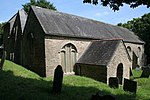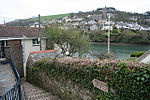Church of St Peter the Poor Fisherman, Revelstoke

The Church of St Peter the Poor Fisherman in the village of Noss Mayo, in Devon, England, was built in 1226. It is located in the former civil parish of Revelstoke. It is recorded in the National Heritage List for England as a designated Grade I listed building, and is a redundant church in the care of the Churches Conservation Trust. It was declared redundant on 6 April 1971, and was vested in the Trust on 28 June 1972.The mediaeval church has Saxon origins with portions being built in the 13th, 14th and 15th centuries. The aisle and the porch still have their carved wagon roofs; however, the roofs have fallen down over the rest of the building.In 1880–82 a new church, also dedicated to St Peter, was built nearby and this church fell into disrepair. It is still consecrated and occasional services are held in the church during the summer.
Excerpt from the Wikipedia article Church of St Peter the Poor Fisherman, Revelstoke (License: CC BY-SA 3.0, Authors, Images).Church of St Peter the Poor Fisherman, Revelstoke
Cow Trail, South Hams Newton and Noss
Geographical coordinates (GPS) Address Nearby Places Show on map
Geographical coordinates (GPS)
| Latitude | Longitude |
|---|---|
| N 50.3003 ° | E -4.0177 ° |
Address
Cow Trail
PL8 1HF South Hams, Newton and Noss
England, United Kingdom
Open on Google Maps








